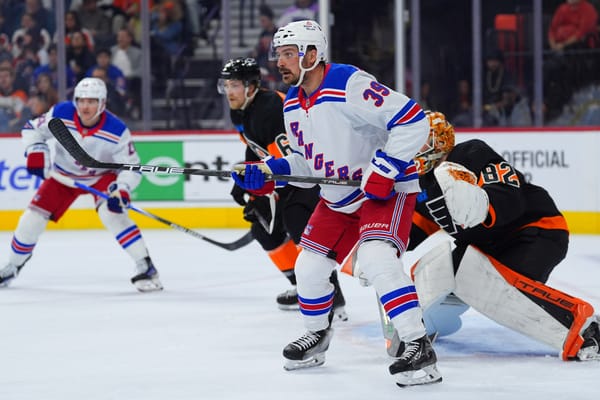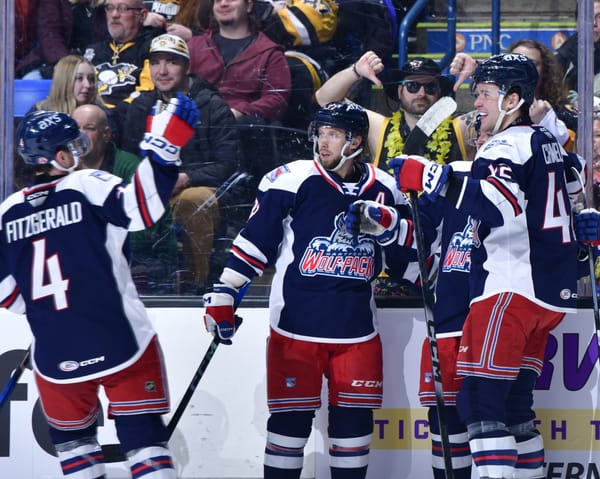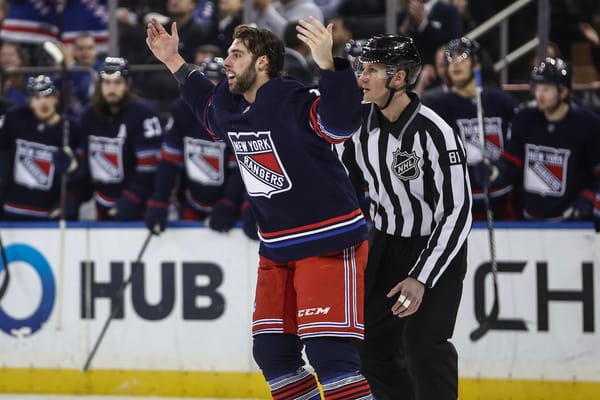2017 Rangers Report Card: Kevin Hayes
After a 2015-16 season that was widely considered a down year from his strong rookie season, Kevin Hayes turned his offseason training up a notch to help him rebound in 2016-17. He bounced back with 49-points (17 goals, 32 assists) in 76 games, a career high, after a 36-point campaign the season prior.
Hayes’s 49 points include seven power play points and seven short-handed points. Twenty-six of those points were scored at 5-on-5, translating to 1.61 per 60. Of those 26 points, 21 were primary (1.3 per 60). While he increased his scoring in all situations, he actually scored more 5-on-5 points last year (29 points, 1.9 per 60). Still, he improved in other areas, like increasing his takeaways from 23 to 44 in the last year.
His possession statistics were some of the worst in his career this year though – some of which has to be attributed in the role he was asked to play this year. Hayes was used in a much more defensive role as the team’s third-line center, most often with J.T. Miller and Michael Grabner on his wings. That defensive role forced him into facing a high number of defensive zone starts, the most in his career and any forward on the team this year (21.1 per 60 according to NaturalStatTrick).
Because of that, along with some tactical changes from head coach Alain Vigneault, he faced a high number of shots attempts (61.25 per 60) and scoring chances against (9.97 per 60) – which contributed to his high expected goals against (2.91 per 60).
However, with lesser possession statistics Hayes still managed to accumulate 5-on-5 points, some of which should be attributed to Grabner and his inflated shooting percentage (15.62 percent). Despite reaching a career high in points, this may not have been the best role for him. Minor line changes, like moving Grabner to a line with Jesper Fast and Oscar Lindberg (as it was done during the postseason) to handle the bulk of the defensive shifts would have suited Hayes better and given him more of the chance to break out, just in a sheltered role.
Then again, shifting Hayes to a defensive role does follow Vigneault’s methodology of developing players (think Ryan Kesler in Vancouver), so it shouldn’t come as a shock – but it doesn’t mean it was necessarily the right thing to do. As much as Hayes’s possession suffered at times this season, the blame isn’t solely on him for that. As Kevin said in March, it was a weird season for him.
By all accounts this looks like a bounce back year for Hayes and his offseason training was such an influential factor on that. Crediting Vigneault with his rebound is short-sighted though, since this isn’t the type of role Hayes should be in to reach his potential. Had he put him in a role that he was better suited for, he would deserve accolades for Hayes’s growth.
Hayes’s postseason wasn’t particularly noteworthy or consistent. There were times in which he played a strong game, others where he clearly struggled. But overall, it’s safe to say it didn't meet expectations. His The Players’ Tribune may have come back to haunt him a bit too, since he gave the impression that he would be a difference-maker after such a rough postseason last year.
When the Rangers season ended, Hayes joined Team USA at the 2017 World Championship and was used in an offensive role with Johnny Gaudreau – yes, we all saw it and wished he could have been that productive in the playoffs. Here’s the thing, a player of Gaudreau’s caliber elevates Hayes’s game and there simply isn’t a player like that in New York. What has to be drawn from it, was how well he played in an offensive role, begging the question if his role should be reconsidered for next season.
Overall this past season, Hayes did reach a career high in points and rebounded from the 2015-16 season after some much-needed offseason training. His work ethic last offseason is commendable because he pushed himself to be a better player. Hayes is such a naturally skilled player, but as we saw last season, it’s simply not enough – he has to build up his game around his strengths, and that training was a major step in doing that.
Hayes shouldn’t be blamed for the position he was assigned this season, nor the tactics he was instructed to follow. He played in that role, but maybe not to the best of abilities as he sometimes appeared to be playing too cautiously – maybe because of the discipline from Vigneault in the past.
All in all, Hayes played in the role he was asked to and on the surface was fine as the third-line center. But if you dig a little deeper, some flaws start to shine through, some of which were out of his control. What was under his control, was using his assets and his skill to drive play, and unfortunately only glimpses of that were seen – which is something to work on for next year.
For the 2016-17 season and postseason, he earned an overall grade of a B.
*5v5 data via Corsica.hockey.




